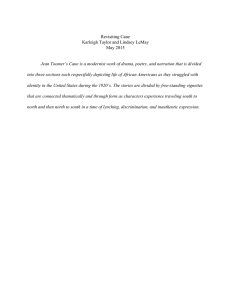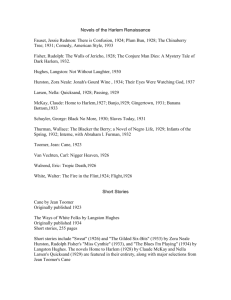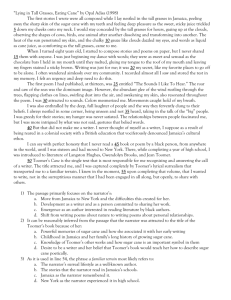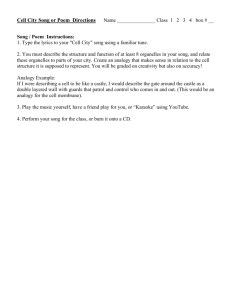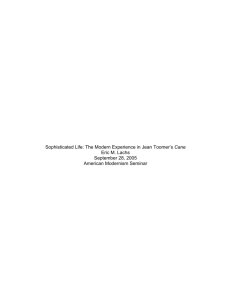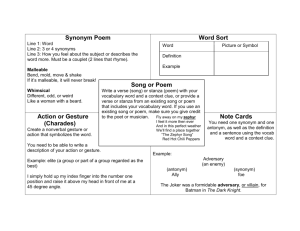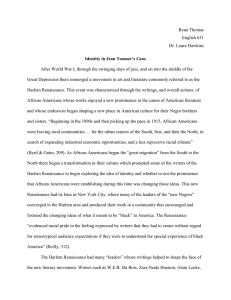Twomore 1 Gene Twomore Eng102 Prof. Mekler February 13, 2008
advertisement
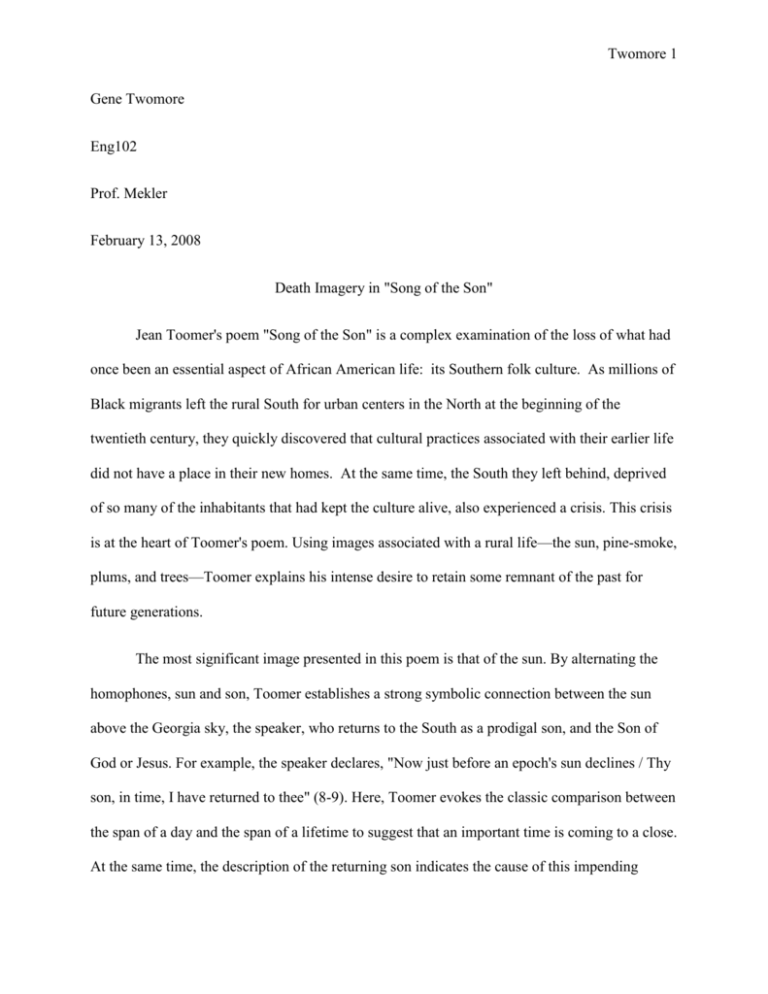
Twomore 1 Gene Twomore Eng102 Prof. Mekler February 13, 2008 Death Imagery in "Song of the Son" Jean Toomer's poem "Song of the Son" is a complex examination of the loss of what had once been an essential aspect of African American life: its Southern folk culture. As millions of Black migrants left the rural South for urban centers in the North at the beginning of the twentieth century, they quickly discovered that cultural practices associated with their earlier life did not have a place in their new homes. At the same time, the South they left behind, deprived of so many of the inhabitants that had kept the culture alive, also experienced a crisis. This crisis is at the heart of Toomer's poem. Using images associated with a rural life—the sun, pine-smoke, plums, and trees—Toomer explains his intense desire to retain some remnant of the past for future generations. The most significant image presented in this poem is that of the sun. By alternating the homophones, sun and son, Toomer establishes a strong symbolic connection between the sun above the Georgia sky, the speaker, who returns to the South as a prodigal son, and the Son of God or Jesus. For example, the speaker declares, "Now just before an epoch's sun declines / Thy son, in time, I have returned to thee" (8-9). Here, Toomer evokes the classic comparison between the span of a day and the span of a lifetime to suggest that an important time is coming to a close. At the same time, the description of the returning son indicates the cause of this impending Twomore 2 death. The departure of so many Southern sons has left the culture neglected and die. Perhaps, Toomer suggests, if more Black people return to their roots, they might be able to resuscitate the past. This celebration of roots becomes reinforced with the introduction of another image: the plum tree. Toomer writes, "O Negro slaves, dark purple ripened plums, / Squeezed and bursting in the pine-wood air, / Passing, before they stripped the old tree bare / One plum was saved for me" (16-19). Again, Toomer uses images of death paradoxically to celebrate the folk culture. The slaves are being squeezed and are bursting from the pressures of their lives, yet, even as slavery destroys them, they are able to capture their emotions and to share with others. Yet, the fruits of their struggle—the spirituals and other folk songs—have been discarded and almost forgotten until Toomer arrives. Fortunately for him—and for subsequent generations—there is still something left to find: "One seed becomes / An everlasting song, a singing tree, / Caroling softly souls of slavery" (19-21). In Toomer's hands, the last remnants can be given new life, and the spirituals can be appreciated indefinitely as a testimonial to the strength and endurance of his slave ancestors. This connection between plums and slaves mirrors the other connection made in the poem between African American slaves and the pine-smoke that is carried along by the valley. The speaker tells the singer to pour out his soul into song, "Into the velvet pine-smoke air tonight, / And let the valley carry it along" (3-4). Like smoke, the song can be carried on the evening breeze, so that it can be heard by people in the surrounding area. At the same time, however, smoke is very light and fragile; it can dissolve very easily into nothing, just as the unrecognized and unappreciated songs that typify slave culture will disappear as the new generation chooses to forget them. Only by recognizing how tenuous the perpetuation of the Twomore 3 culture is, Toomer suggests, can new generations of African Americans become motivated to save it from oblivion. Although Toomer was not alone in his appreciation of the folk culture, he certainly found himself with few kindred thinkers. Fortunately, the publication of this poem in 1922, and again in 1923 as part of Cane, succeeded in bringing new life to the African American artistic spirit. Work Cited Toomer, Jean. "Song of the Son." Cane: An Authoritative Text, Backgrounds, Criticism. Ed. Darwin Turner. NY: Norton, 1988. 14. Questions: Outline: What is the thesis statement? Is this a clear statement? Explain. Is the outline presented in proper format? Is there proper balance between sections? Do any parts seem unrelated to the main argument? Explain. Paper Proper: Is the thesis presented clearly? Explain. Does the author adequately support it? Explain. Does the person follow the organization of ideas found in the outline? Explain. Does the writer properly cite the quotes? Do the quotes adequately fit in to the discussion where they are found? Do they support the writer's claims? Explain. Are there parts of the paper that are difficult to understand? Explain. If present, is the Works Cited presented in proper format? Explain. Any other comments or suggestions?
